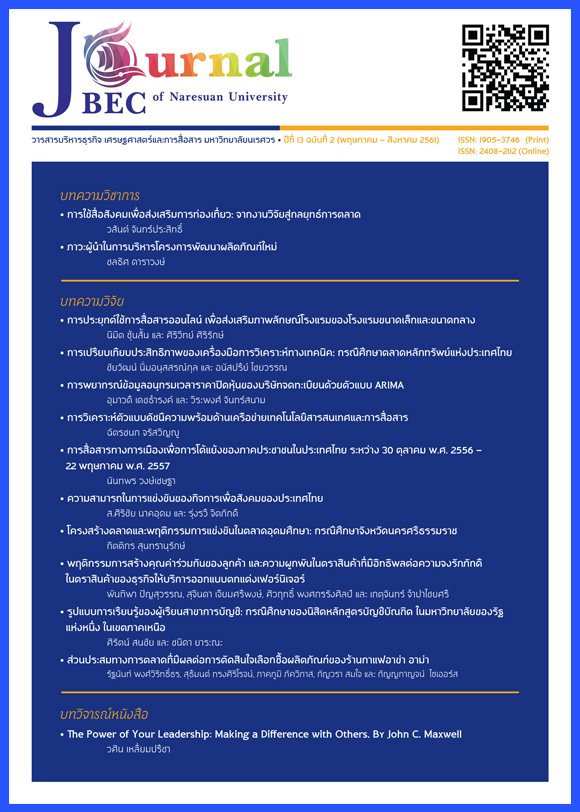ความสามารถในการแข่งขันของกิจการเพื่อสังคมของประเทศไทย [Competitiveness of Social Enterprise in Thailand]
Main Article Content
บทคัดย่อ
การศึกษาครั้งนี้มีวัตถุประสงค์เพื่อ 1) วิเคราะห์ความสามารถในการแข่งขันของกิจการเพื่อสังคมของประเทศไทย 2) วิเคราะห์จุดแข็ง จุดอ่อน โอกาส และอุปสรรคและกำหนดกลยุทธ์การพัฒนาขีดความสามารถกิจการเพื่อสังคมของประเทศไทย โดยการสัมภาษณ์เชิงลึกจากผู้เกี่ยวข้องจำนวน 20 ราย ใช้เครื่องมือการวิเคราะห์ตามแบบจำลองเพชรพลวัต (Dynamic Diamond Model), SWOT Analysis และ TOWS Matrix ผลการศึกษาพบว่า 1) ปัจจัยการผลิตยังไม่สามารถตอบสนองต่อการแข่งขัน 2) อุปสงค์ส่วนใหญ่เป็นรูปแบบของอุปสงค์เทียม 3) การบูรณาการองค์กรที่เกี่ยวข้องมีความสอดคล้อง 4) สภาพการแข่งขันทางธุรกิจในปัจจุบันไม่เอื้อต่อการแข่งขัน 5) กระแสการพัฒนาอย่างยั่งยืนเป็นโอกาสทำให้ ภาครัฐ ภาคเอกชน และภาคประชาชน เล็งเห็นถึงความสำคัญ 6) รัฐบาลสนับสนุนนโยบายประชารัฐรักสามัคคี ซึ่งเป็นแนวทางในการพัฒนาความสามารถในการแข่งขันของกิจการเพื่อสังคม และกลยุทธ์การพัฒนาขีดความสามารถกิจการเพื่อสังคมของประเทศไทย ได้แก่ 1) กลยุทธ์การมีส่วนร่วมของสังคมและชุมชน 2) กลยุทธ์การใช้ทุนทางสังคมและทุนทางวัฒนธรรม 3) กลยุทธ์การประชาสัมพันธ์ถึงคุณภาพสินค้าของกิจการเพื่อสังคม 4) กลยุทธ์ปรับปรุงโครงสร้างเพื่อให้สอดรับกับการแข่งขัน 5) กลยุทธ์การสร้างเครือข่ายแลกเปลี่ยนเรียนรู้ 6) กลยุทธ์แหล่งเงินทุนระยะเริ่มต้นและระยะดำเนินการ 7) กลยุทธ์พัฒนาระบบให้คำปรึกษาและแก้ปัญหาในการดำเนินธุรกิจ
Article Details
References
2. Bourdieu, P. (1986). The forms of capital in Richardson, J., Handbook of theory and research for the sociology of education. New York: Greenwood.
3. Chiangkul, W. (2015). Why need to read Karl Marx?. Bangkok: Sangdao.
4. Dees, J. G. (1998). Social enterprise: Private initiatives for the common good. Harvard Business Review, 76(1), 54-68.
5. Ebrashi, R. E. (2013). Social entrepreneurship theory and sustainable social impact. Social Responsibility Journal, 9(2), 188-209.
6. Elkington, J. (1997). Cannibals with forks: The triple bottom line of twenty-first century business. Capstone: Oxford.
7. Haugh, H. (2006). A research agenda for social entrepreneurship. Social Enterprise Journal, 1(1), 1-12.
8. Jiao, H. (2011). A conceptual model for social entrepreneurship directed toward social impact on society. Social Enterprise Journal, 7(2), 130-149.
9. Kerlin, J. A. (2006). Social enterprise in the United States and Europe: Understanding and learning from the differences. Voluntas, 17(3), 247-263.
10. Meadows, M. and Pike, M. (2010). Performance management for social enterprises. Systemic Practice and Action Research, 23(2), 127-141.
11. Mulgan, G. (2006). Cultivating the other invisible hand of social entrepreneurship: Comparative advantage, public Policy and future research priorities. In A.Nicholls (Ed.), Social entrepreneurship: New models of sustainable social change (pp.74-95). Oxford: Oxford University.
12. Munro, M. M. and Belanger, C. (2017). Analyzing external environment factors affecting social enterprise development. Social Enterprise Journal, 13(1), 38-52.
13. Nantharojphong, K., Kittisaknawin, C. and Deesawad, N. (2017). Organization development intervention in digital economy era for the high performance organization. Journal of Business, Economics and Communications, 12(2), 23-34.
14. Pearce, J. (2003). Social enterprise in any town. Lisbon: CalousteGulbenkian Foundation.
15. Porter, M. E. (1990). The competitive advantage of nations. New York: Free Press.
16. Suthiwartnarueput, K. (2009). Management for competitiveness - new model and new frames. Chulalongkorn Business Review, 31(4), 66-74.
17. The Working Group Members on Local Economic and Public-private Collaboration. (2016). Pracharath Rak Samakkee handbook 2. Retrived August 24, 2016, from http://prsthailand.com/th/download
18. UK Department for Trade and Industry. (2002). Social enterprise: A strategy for success. Cambridge: Harvard Business School.

